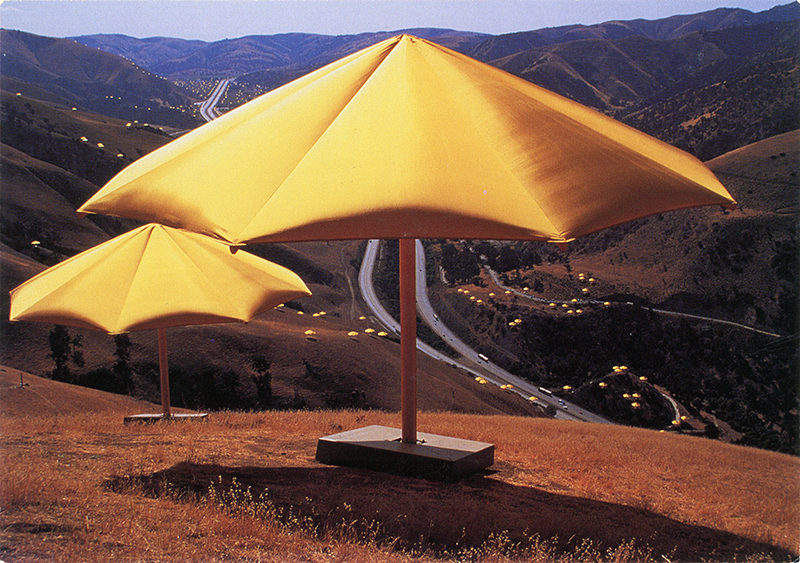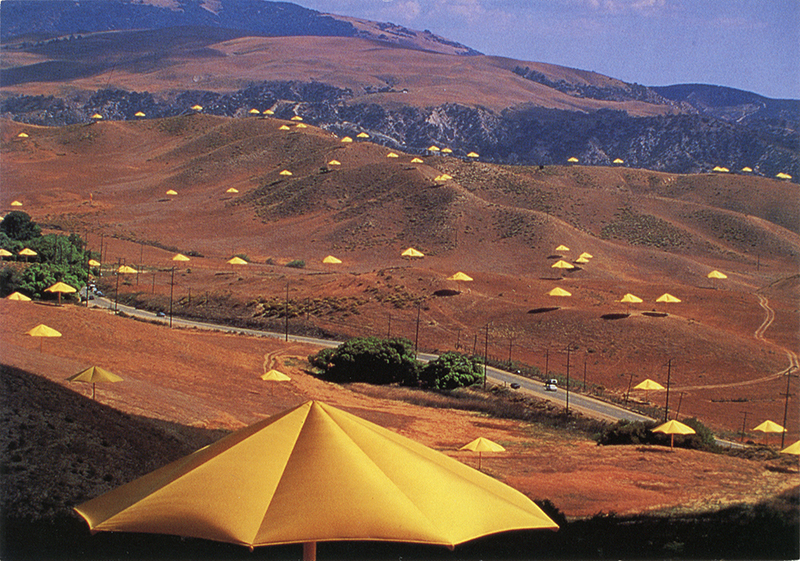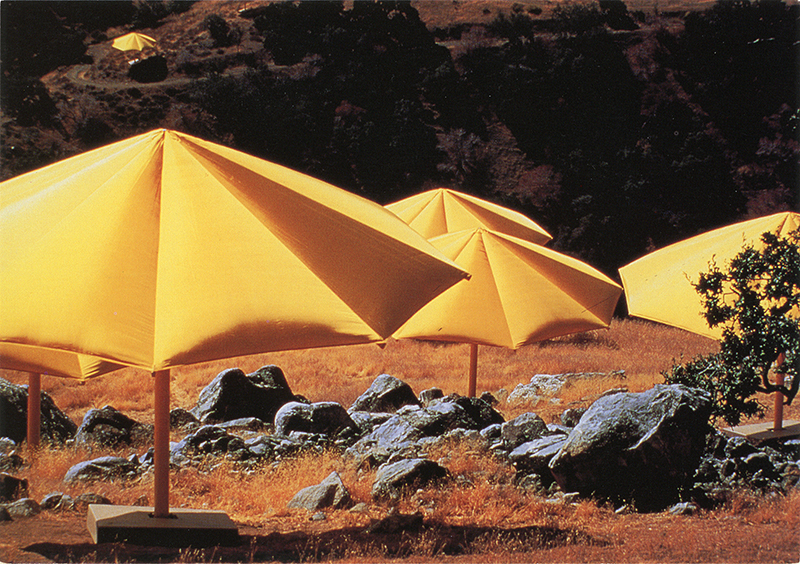|
Bulgarian environmental artist Christo (Christo Vladimirov Javacheff) and his Casablanca-born wife Jeanne-Claude Denat de Guillebon have created outdoor public art all over the world. In 1991 they unfolded "The Umbrellas Japan-USA," a temporary, bicontinental installation of 3,100 umbrellas in California and Japan.
All fabricated in Bakersfield, 1,340 huge blue umbrellas were shipped to Ibaraki, 75 miles north of Tokyo, while 1,760 California golden poppy-colored umbrellas were installed by A.L. Huber & Son along an 18-mile stretch of mountainsides in the Tejon Pass from Gorman on the south to Grapevine on the north.
Each measuring 19'8" tall and 28'5" in diameter and weighing 485 pounds, the umbrellas consisted of fabric stretched around an aluminum superstructure with a steel-frame base. The project cost $26 million and was entirely self-financed by the artists.
Installation of the bases began in December 1990. In California, it took the cooperation of more than two dozen landowners including Tejon Ranch Co. and government agencies. Using helicopters and nearly 2,000 people (960 in California, 920 in Japan), the umbrellas were placed on the bases in September and October 1991.
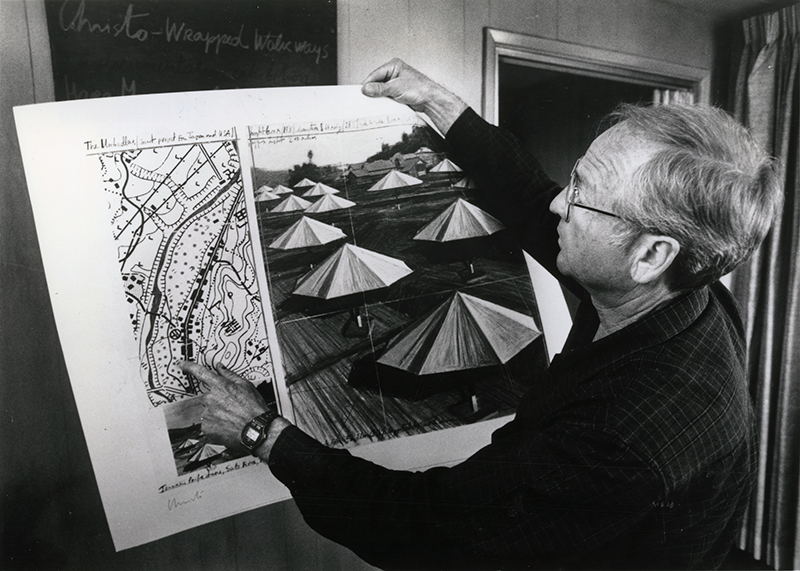
Project director Vince Davenport displays a print of the Japan portion of the project. Photo: David Colker/L.A. Times. Click to enlarge
| Download archival scan
|
Their opening on October 9 was a spectacle that was intended to last just 21 days but was cut short after 18 days. On October 26 in the notoriously windy Tejon Pass, a 33-year-old spectator, Lori Mae Matthew of Camarillo, was killed when high winds ripped an umbrella from its mooring and blew it across a road, crushing her against a boulder and injuring several other people. Christo ordered the installation in both locations to be closed immediately "out of respect to her memory," his statement said.
Disassembly began October 27 and was equally deadly. On October 31, crane operator Masaaki Nakamura, 51, was electrocuted when his machine's arm hit a high-tension line while he was helping to remove umbrellas in Japan.
The land was returned to its original condition, and most elements of the umbrellas were recycled, the artists said.
Christo's artistic pursuits began in his native Bulgaria where he attended the Sofia Academy of Fine Arts. Fearing further Soviet oppression during a transitional political period, he fled in a freight car to Vienna where he surrendered his passport and studied at the Fine Arts Academy. He ended up in Paris in 1958 and eked out a living by painting portraits of wealthy socialites. There he met Jeanne-Claude, who helped him expand his palette. The duo's first outdoor environmental project came in 1961 when they installed a pile of oil barrels and industrial paper rolls covered in tarp at the harbor in Cologne, West Germany. According to Artnet News (May 31, 2020), "The resulting sculpture seemed to humanize the piles, as if they were very conspicuously trying to make themselves invisible by covering themselves with a sheet." The artists gained attention in 1962 when they illegally blocked the Rue Visconti in Paris with a 14-foot-high wall of oil barrels they called "Iron Curtain" in protest against the newly erected Berlin Wall.
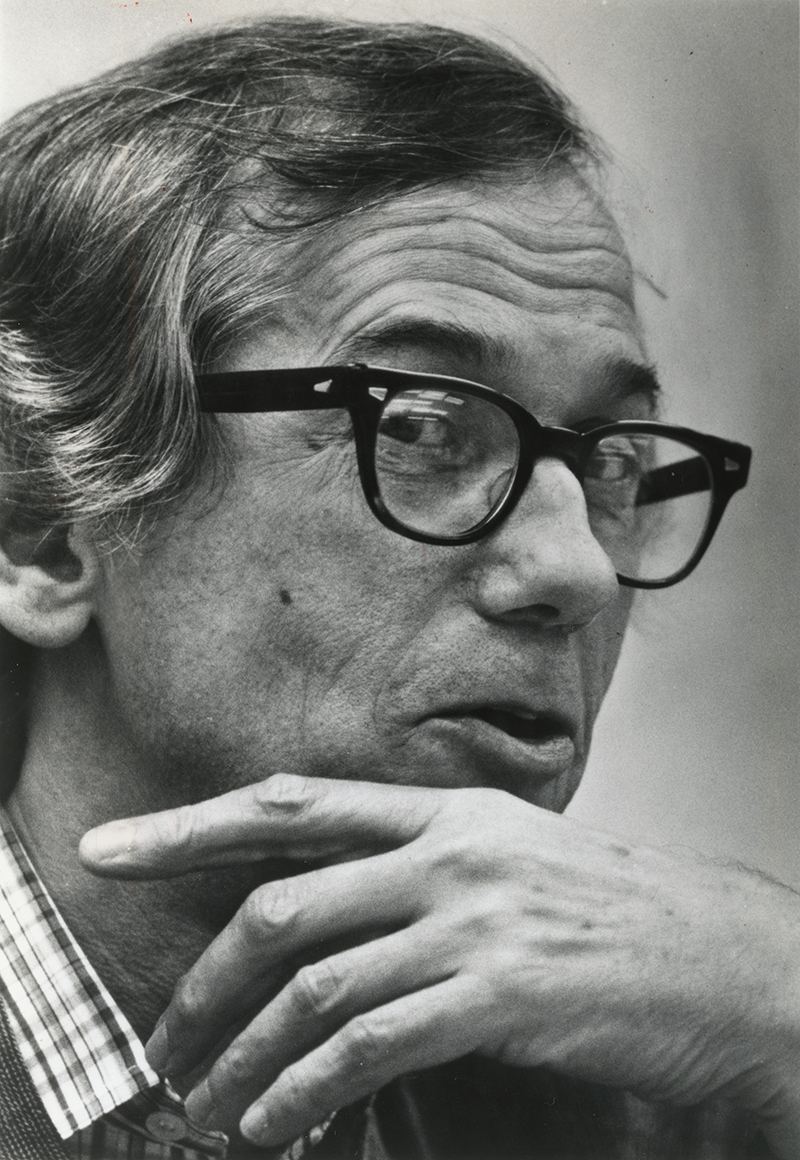
Christo in 1991. Click to enlarge.
|
Stateless since his Vienna arrival, Christo immigrated to the United States and became a U.S. citizen in 1973.
Notable projects included "Surrounded Islands" in Biscayne Bay, Miami (1983); "Wrapped Reichstag" in Berlin (1995); "The Gate" in New York's Central Park (2005), which then-Mayor Michael Bloomberg called "one of the most exciting public art projects ever put on anywhere in the world;" and "Floating Piers," a 1.9-mile walkway of 200,000 buoyant cubes on Italy's Lake Iseo (2016). The latter proved too popular, attracting hundreds of thousands of visitors who reportedly overwhelmed the area's infrastructure.
Not all of Christo's projects panned out. While Christo and Jeanne-Claude completed 23 projects together, 47 never saw the light of day.
Christo and Jeanne-Claude were born the same day (June 13, 1935). Jeanne-Claude died from a brain aneurysm in 2009. Christo died from natural causes at home in New York City on May 31, 2020. He was 84.
In an Artnet News interview published two months prior to his death, Christo described his projects as "totally irrational, totally useless. Nobody needs them. The world can live without them." A self-described "educated Marxist," he said of his creations' ephemeral nature: "They exist in their time, impossible to repeat. That is their power, because they cannot be bought, they cannot be possessed. ... They cannot be seen again."
At the time of his death, his latest project, to wrap the Arc de Triomphe in Paris, first proposed in 1962, was nearing completion. His studio issued a statement saying the project was still on track for six days in the fall of 2021. "Christo and Jeanne-Claude have always made clear that their artworks in progress be continued after their deaths," the statement said.
| 